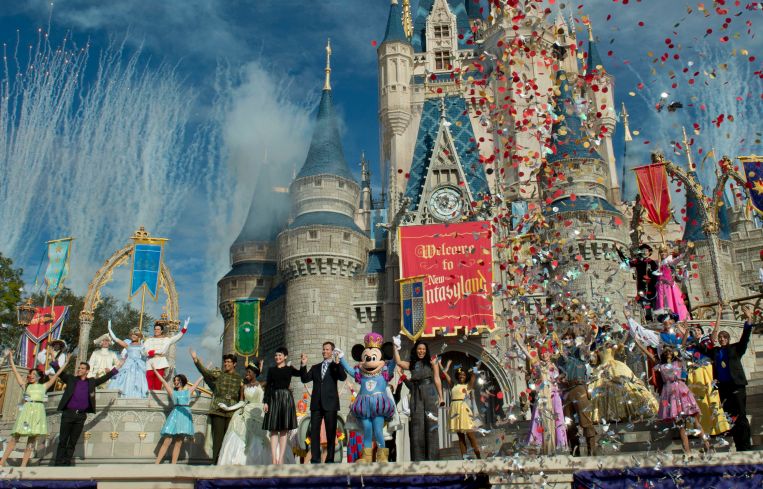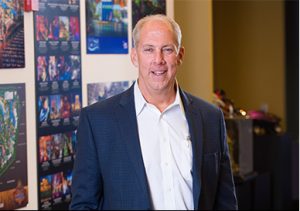Real Estate Developers: Look to Theme Parks

Mixed-use projects, which blend commercial, residential, retail and more, have become increasingly popular across the United States as real estate developers have come to realize they are not just selling properties but also promoting their communities. Yet, many CRE developers end up running into the same challenge of differentiating themselves from competitors, making it difficult to procure tenants at the desired leasing price.

Property differentiation is not a new issue in real estate, nor does it have a clear solution. Global interest in elaborate mixed-use developments opens the doors for CRE developers to use common disciplines of theme park development that enhance guest experiences to set their property apart. Whereas theme parks are more interested in high-intensity visits for entertainment, mixed-use should consider theme park elements to create more consistent, but equally immersive experiences to keep guests engaged and returning to the property.
What does selling an experience actually mean?
Marketing an experience versus a product, at times, can seem like overdone puffery. But there is a fundamental difference between the two that dramatically increase engagement and spending. Consider a cab driver that takes a vacationer from the airport to a resort. This interaction will likely elicit a standard tip and be forgotten moments later. However, let’s say the same cab driver instead offers to take the individual on a quick tour of local “hidden gems” they would otherwise not see at the touristy resort. The cab driver has turned a basic transaction into an experience, which will lead to a higher fare for more distance traveled, a better tip, and a memory for the tourist.
This is metaphorically similar to what properties gain from creating experiences versus standard development projects. It is also exactly what theme parks have mastered since Walt Disney opened Disneyland almost 63 years ago. Theme parks keep guests at a location longer, coaxing more from their wallets and increasing the likelihood that they will return. Retailers co-located in theme parks are able to sell premium merchandise at high volume because shopping has transformed into an extension of the overall experience. Mixed-use facilities could stand to incorporate more of these elements into their developments.
A designer of experience is interested in the ground-level perspective
The core difference between a traditional real estate developer and a designer of experience stems from how each one views a project. Most developers focus on a bird’s eye, 3,000-foot perspective with site planning and adjacencies becoming critical to decision making while a designer of experience is most interested in beginning with the ground-level, 5-foot view instead—the perspective the guest or tenant will have.
Property owners typically focus on a development’s ideal location relative to the environs, such as how far is it from downtown, or, what kind of access it has to transportation. There is quite often a real estate perspective mostly concerned with leasing space at a great price, sale of land, and then moving on to the next project. In terms of process, owners generally are interested in pursuing the anchor tenant, and then adding complementary content around them. Their primary interests concerning patrons that will frequent the property is more functional, such as where a free Wifi station, charging station, or restrooms will be dispersed.
A designer of experience is far more interested in making that location into an appealing and therefore lucrative destination, with patrons wanting to visit more often and for long periods of time rather than stopping by for the convenience of being close by.
This shift in priority also creates a drastically different real estate development process. First, a designer of experience seeks to create a story, a theme, a raison d’etre as a figurative foundation for a project. Disney Springs is a great example of the effect this can have on customer engagement. There are plenty of springs in Florida, but Disney analyzed their surrounding area and realized that there are over 100 years of diverse architecture surrounding the specific spring they planned to build on. Disney leveraged the rich architectural history of the area to develop a story around this concept, weaving the spring through its properties and creating corresponding events which now have a believable reason to exist. This, in turn, makes the location special.
Once the theme and story are determined, every subsequent decision about the property is carefully woven into the experience from the entertainment elements down to the different shops or restaurants. This is often where technology is implemented to develop elements that engage with all five senses. Scents and lighting control, although subtle, can create an immersive experience. These elements also provide new ways for the property to entice tenants to lease property at a higher value. Most people do not realize that theme parks are constructed so that every pathway, ride, show, store or restaurant is a controlled Guest experience. By focusing on the ground-level view of the property, a developer can target specific brands that fit the themed destination and improve marketability of that property and why they should lease the space.
Incorporating traditional theme park elements such as a certain amount of “experiences per hour” is also an excellent method for enhancing stickiness in mixed-use development. Mall of America in Minnesota employs this tactic with weekly in-store events such as a shoe-tying classes for kids in nordstrom’s, in addition to providing a Nickelodeon themed indoor theme park. This same concept is also the reason fireworks inside theme parks happen so late at night. Research shows that guests spend more in the evening, so some of the most exciting events happen just before parks close, to entice visitors to stay the full day. A healthy combination of both timed and stagnant entertainment and events is crucial, and works best if it meshes perfectly with the story of the development.
Experience-based real estate is a logical progression to keep up with increasing need for differentiation for both tenants and patrons that frequent the property. Owners and developers are already understanding the importance of blending traditionally disparate properties into one location to create something new but should also strongly consider taking it one step further and overhaul their development process to venture from the traditional approach. Using an experiential design process that focuses more on the guest experience at its core will help maximize the value of the property and improve marketability of the project.
Bill Coan is the president and CEO of ITEC Entertainment directing the creative development of all ITEC-themed entertainment projects.


